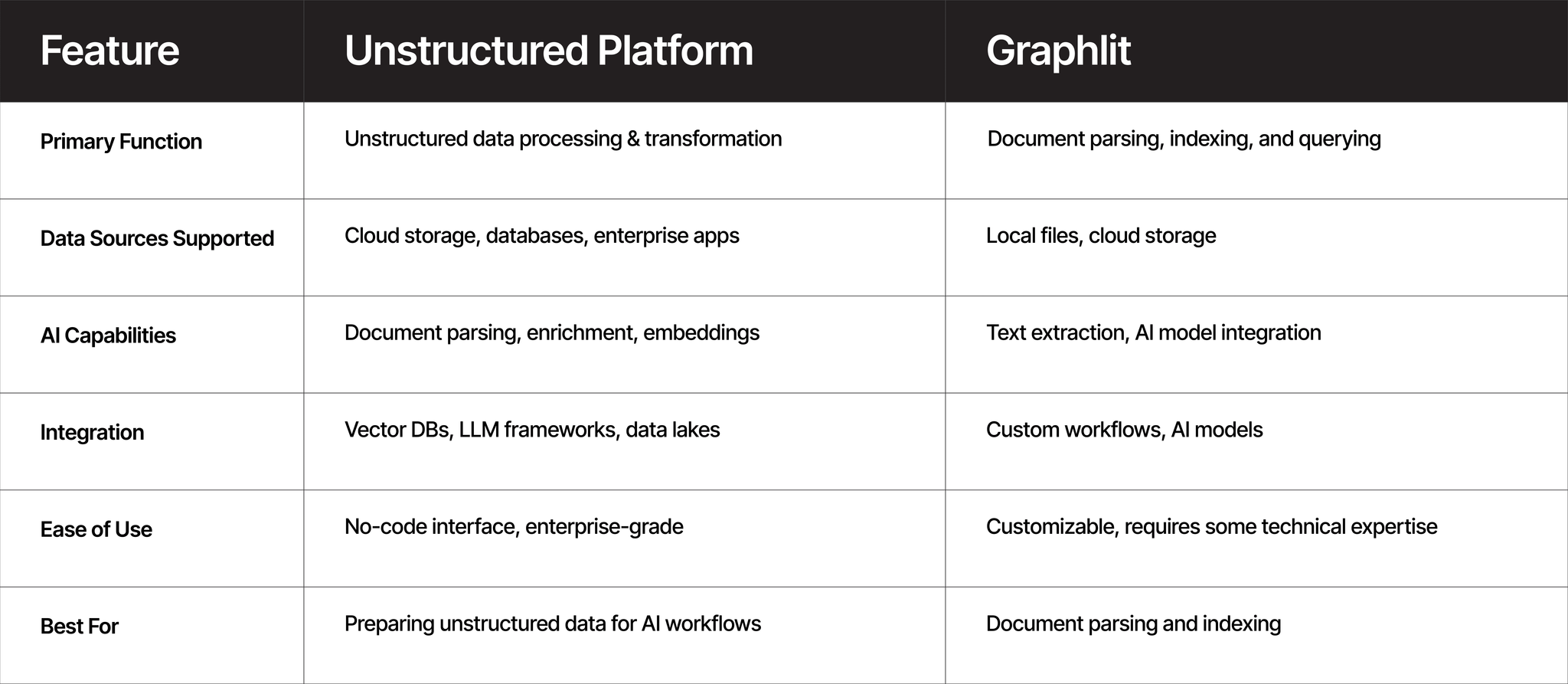
Authors

If your primary goal is to prepare unstructured data for AI applications, the Unstructured Platform is the ideal choice. It offers a no-code solution for converting raw documents like PDFs, emails, and scanned files into structured, machine-readable formats, making it perfect for Retrieval-Augmented Generation (RAG) systems and enterprise data pipelines.
Try out the Unstructured Platform today. Learn more here.
What is Unstructured?
The Unstructured Platform is a specialized solution designed for transforming unstructured data—such as PDFs, emails, and scanned documents—into structured, machine-readable formats. It supports various document processing workflows, making it an ideal choice for AI applications, Retrieval-Augmented Generation (RAG) systems, and enterprise data pipelines.
Key Features of Unstructured
- No-Code Data Processing: Enables users to convert raw unstructured data into a structured format without writing custom code.
- Diverse Data Source Support: Connects to cloud storage services (AWS S3, Azure Blob, GCP), databases (Databricks, Elasticsearch, OpenSearch), and enterprise platforms (Salesforce, Google Drive, SharePoint).
- Advanced Partitioning & Chunking: Uses multiple partitioning strategies (Fast, HiRes, Auto) and intelligent chunking methods (By Title, By Page, By Similarity) to optimize content extraction.
- AI-Powered Enrichment: Generates metadata, captions, and embeddings for AI-driven document retrieval and analysis.
- Vector Database Integration: Seamlessly integrates with Pinecone, Weaviate, Chroma, Elasticsearch, OpenSearch, and other storage destinations.
- Scalability for Enterprise AI: Designed to handle high-volume ETL workloads.
Workflow Orchestration Engine
The platform’s orchestration layer manages complex scheduling, automatic retries, and parallel processing of over 53,000 documents per job while maintaining millisecond latency between processing steps. Unlike limited frameworks that focus solely on specific tasks, Unstructured provides end-to-end orchestration capabilities, including:
- Real-time document detection with automated triggering of processing pipelines.
- Intelligent incremental updates that reprocess only modified content.
- Horizontal scaling across multiple data planes in hybrid cloud environments.
- Embedded metadata governance tracking data lineage from source to vector store.
Enterprise Scalability
Performance benchmarks indicate that the hosted SaaS deployment processes over 15 million pages per hour per workflow, with proven scalability to petabytes of unstructured data. For organizations requiring full control, the in-VPC deployment model eliminates data egress costs while providing unlimited scaling based on private infrastructure capacity. This architecture supports multi-region processing with centralized governance, essential for global enterprises managing localized data residency requirements.
Enterprise Integrations
With over 71 pre-built connectors spanning storage systems, LLM providers, and vector databases, Unstructured Platform acts as the central nervous system for GenAI data pipelines. Current production integrations include direct access to OpenAI and Anthropic models for embeddings and enrichment, with expanded model support scheduled for Q2 2025. The platform’s API-first design allows custom integration with any third-party service while maintaining SOC 2 Type 2 compliance across all data flows.
Read more about how Unstructured can help you do Production-Ready data processing for GenAI here.
What is Graphlit?
Graphlit is a document processing platform that focuses on extracting and structuring data from unstructured documents. It provides tools for parsing, indexing, and querying documents, making it suitable for applications that require high-quality data extraction for AI and analytics workflows.
Key Features of Graphlit
- Document Parsing: Extracts text, tables, and metadata from unstructured documents.
- Indexing and Querying: Provides tools for indexing and querying documents, enabling efficient retrieval of information.
- Integration with AI Models: Supports integration with AI models for tasks like summarization, classification, and entity recognition.
- Customizable Workflows: Allows users to define custom workflows for specific document types and use cases.
Unstructured vs. Graphlit: A Feature Comparison

Choosing the Right Document Processing Tool for Your Use Case
The Unstructured Platform is designed to simplify the process of preparing unstructured data for AI applications. Its no-code interface, extensive integrations, and enterprise-grade scalability make it a strong choice for organizations looking to streamline their document processing workflows.
At Unstructured, we're committed to simplifying the process of preparing unstructured data for AI applications. Our platform empowers you to transform raw, complex data into structured, machine-readable formats, enabling seamless integration with your AI ecosystem. To experience the benefits of Unstructured firsthand, get started today and let us help you unleash the full potential of your unstructured data.


